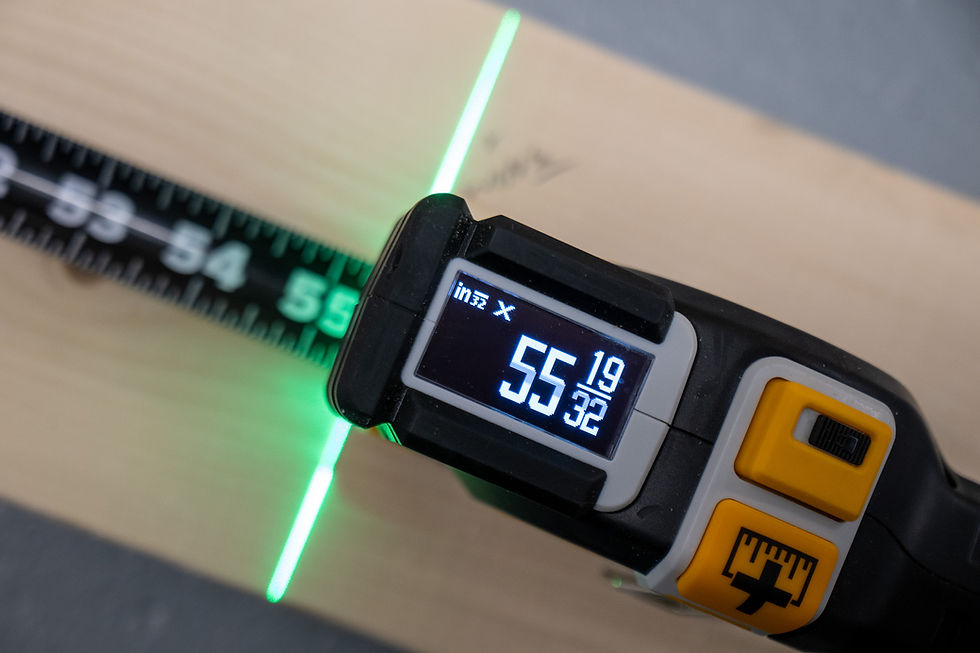How to Read a Tape Measure
- Derrick Rock

- May 30
- 3 min read
Updated: Jun 17

One of the most common tools on any home improvement or construction project is a tape measure. Reading a tape measure doesn't need to be complicated. REEKON Tools has put together the below guide to outline the breakdown of how to read a tape measures, what all the markings on the tape printing mean, and some other terms you will see in its use.
Reading Fractional Markings

The longest lines are your inch markers. They’re bold, they’re numbered, and they’re easy to find. Every full inch gets one.
Halfway between those inches is a slightly shorter line. That’s your 1/2 inch. You’ll only see one per inch.
Split the inch even further, and you’ll find 1/4" and 3/4" marks, the next longest lines after the half. There are two per inch, right between the inch and the half.
Going tighter, you’ll see your 1/8 inch increments. These break each quarter into two pieces, giving you four of these per inch.
Finally, the shortest lines on the tape mark 1/16 inch. These are tiny but powerful, and they give you the precision needed for fine finish work. You’ll find eight of these per inch.
That’s 16 marks per inch total. Once you know how to spot which ones are which, reading any measurement becomes second nature. Some tapes may even have another set of lines in each gap indicating a 1/32" increment.
Stud Marks, Diamond Marks, and What They Mean
Most standard tapes have two special indicators printed on them.

Stud Marks
These are stud spacing marks (common in wall framing). Place a stud every 16 inches and you’re building to code.

Diamonds
These are truss/joist layout indicators for engineered spacing. They can be found ever 19.2 inches which means you’ll see 5 diamonds per 96” (8-foot sheet). This is perfect for laying out supports under full sheets of plywood or OSB.
Why the Tape Hook Moves
(And Why That’s a Good Thing)
The metal hook at the end of your tape measure is designed to move back and forth exactly the thickness of the tape hook metal (usually around 1/16"). When you pull the tape (outside measurement), the hook is pulled tight—the tape starts at zero as it is measuring from the inside portion of the metal tip) When you push the tape (inside corner), the hook compresses inward. This compensates for the hook’s thickness and allows it to measure from the outside of the metal.
Without that play? Every inside or outside measurement would be off by the thickness of the metal.

Understanding “Light” and “Heavy” Measurements
In the trades, we don’t always measure to the exact tick. Sometimes, it’s faster and more practical to work just a little before or just past a marked fraction. That’s where “light” and “heavy” come in.

“Light” Means Just Under
If someone says “cut it light 1/2”, they mean just shy of 1/2". Maybe closer to 7/16", but not quite. You’re easing up on the size, not going all the way to the next tick.
Common phrases you might hear on the site:
“Light 1/4”
“Just shy of 3/8”
“Hair under a half”

“Heavy” Means Just Above
“Go a heavy 3/4”” means just over the 3/4" mark—closer to 13/16", but not right on it. You're giving it a little extra room—just enough to make it fit or stay snug.
Common phrases you might hear on the site:
“Heavy 1/2”
“Touch past 5/8”
“Just fat of a quarter”
Not All Tape Blades Are Built The Same
Tape measure blades vary more than you think, and all styles are made to match how and where you work.

Quick Reference: Tape Measure Fractions

What’s the Pattern on the Bottom of a REEKON Tape?
The black-and-white pattern along the bottom edge of a REEKON tape blade is a high-precision digital tracking system used by our tape measures to read blade position with extreme accuracy. It acts like a barcode for measurements. As the blade extends, the onboard sensor reads this pattern to deliver real-time digital measurements to the screen without guessing or slippage. This system makes REEKON digital tapes faster, smarter, and more reliable than anything else on the job site.
Want to Skip All That Counting? Use a Digital Tape Measure
The T1 Tomahawk reads it for you. Fractions, decimals, or metric—displayed clearly on the screen. No squinting. No second-guessing.





Comments